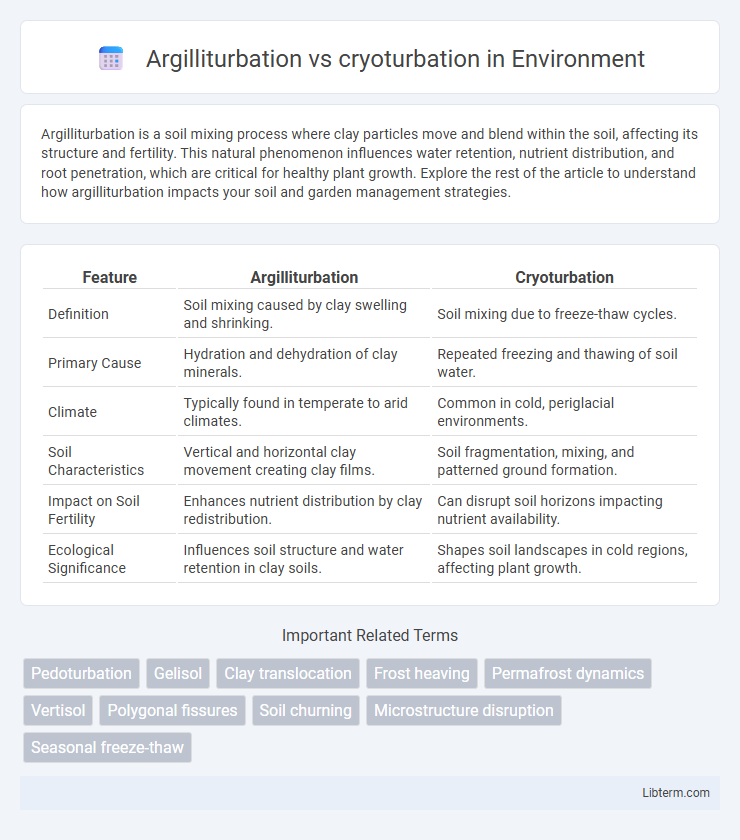Argilliturbation is a soil mixing process where clay particles move and blend within the soil, affecting its structure and fertility. This natural phenomenon influences water retention, nutrient distribution, and root penetration, which are critical for healthy plant growth. Explore the rest of the article to understand how argilliturbation impacts your soil and garden management strategies.
Table of Comparison
| Feature | Argilliturbation | Cryoturbation |
|---|---|---|
| Definition | Soil mixing caused by clay swelling and shrinking. | Soil mixing due to freeze-thaw cycles. |
| Primary Cause | Hydration and dehydration of clay minerals. | Repeated freezing and thawing of soil water. |
| Climate | Typically found in temperate to arid climates. | Common in cold, periglacial environments. |
| Soil Characteristics | Vertical and horizontal clay movement creating clay films. | Soil fragmentation, mixing, and patterned ground formation. |
| Impact on Soil Fertility | Enhances nutrient distribution by clay redistribution. | Can disrupt soil horizons impacting nutrient availability. |
| Ecological Significance | Influences soil structure and water retention in clay soils. | Shapes soil landscapes in cold regions, affecting plant growth. |
Introduction to Soil Turbation Processes
Soil turbation processes, including argilliturbation and cryoturbation, play critical roles in soil formation and landscape evolution by mixing soil horizons through physical and chemical mechanisms. Argilliturbation involves the swelling and shrinking of clay minerals causing the vertical movement of soil particles, often seen in vertisols with high smectite content. Cryoturbation, common in permafrost and cold climates, results from freeze-thaw cycles that disrupt soil layers, creating patterned ground and influencing organic matter distribution.
Defining Argilliturbation
Argilliturbation refers to the physical mixing and churning of soil caused by the swelling and shrinking of clay minerals, leading to disrupted soil horizons and the formation of characteristic clay cutans. This process contrasts with cryoturbation, which involves soil disturbance driven by freeze-thaw cycles in cold climates, resulting in patterned ground and frost heave features. Understanding argilliturbation is crucial for interpreting clay-rich soil profiles, especially in temperate and semi-arid regions where clay expansion significantly alters soil structure and horizon differentiation.
Understanding Cryoturbation
Cryoturbation refers to the physical disturbance of soil layers caused by freeze-thaw cycles, leading to the mixing and churning of soil materials, significantly impacting soil structure and nutrient distribution in cold environments. This process contrasts with argilliturbation, which involves clay movement and soil mixing primarily driven by swelling and shrinking of clay minerals in response to moisture changes. Understanding cryoturbation is crucial for studying permafrost dynamics, soil carbon storage, and vegetation patterns in alpine and polar regions.
Mechanisms Behind Argilliturbation
Argilliturbation involves the physical mixing and churning of clay-rich soil layers due to swelling and shrinking cycles triggered by moisture changes, leading to soil horizon disturbance. This mechanism causes clay particles to move vertically and laterally, altering soil structure and nutrient distribution. In contrast, cryoturbation is driven by freeze-thaw cycles that disrupt soil through ice lens formation and thawing, primarily impacting colder environments.
Mechanisms Behind Cryoturbation
Cryoturbation involves the freeze-thaw cycles in permafrost regions causing soil and sediment mixing, driven primarily by ice lens formation and soil heaving. This process disrupts soil horizons more vigorously than argilliturbation, which is dominated by clay swelling and shrinking due to moisture fluctuations. Cryoturbation affects soil organic matter distribution and mineral weathering by actively transporting materials vertically and laterally within Arctic and sub-Arctic ecosystems.
Key Differences: Argilliturbation vs Cryoturbation
Argilliturbation involves the mixing and churning of clay-rich soils due to wetting and drying cycles, often resulting in the formation of distinct clay skins and structural reorganization within the soil profile. Cryoturbation occurs in permafrost or cold environments where freeze-thaw cycles mechanically disturb the soil, leading to patterned ground and the incorporation of organic material into deeper horizons. The key differences lie in their driving mechanisms--moisture-induced clay movement for argilliturbation versus temperature-driven freeze-thaw processes for cryoturbation--and their typical environmental settings, with argilliturbation prevalent in temperate to semi-arid regions and cryoturbation characteristic of tundra and alpine ecosystems.
Environmental Conditions Favoring Argilliturbation
Argilliturbation occurs primarily in environments with fine-textured clay soils that experience significant wetting and drying cycles, promoting the movement and mixing of soil particles. This process is favored in temperate to semi-arid climates with moderate moisture availability, allowing clay minerals to swell and shrink, which enhances soil churning. In contrast, cryoturbation is dominant in periglacial or cold regions where freeze-thaw cycles disrupt and displace soil layers.
Environmental Conditions Favoring Cryoturbation
Cryoturbation occurs primarily in permafrost regions where freeze-thaw cycles dominate soil processes, causing the physical mixing of soil layers. Environmental conditions favoring cryoturbation include consistently low temperatures below freezing during winter and seasonal thawing in the summer, which promote ice lens formation and soil heaving. Unlike argilliturbation, which is driven by clay shrink-swell dynamics in temperate climates, cryoturbation is strongly associated with cold, subarctic, and arctic ecosystems.
Soil Profile and Property Changes
Argilliturbation involves the mixing and translocation of clay particles within the soil profile, leading to the development of distinct clay-enriched layers and increased soil plasticity. Cryoturbation, caused by freeze-thaw cycles, disrupts soil horizons by physically deforming the soil profile, resulting in patterned ground features and the incorporation of organic material into mineral layers. Both processes significantly alter soil structure and nutrient distribution, but argilliturbation primarily affects clay content and soil cohesion, while cryoturbation influences soil porosity and temperature dynamics.
Implications for Soil Management and Agriculture
Argilliturbation, the mixing of soil layers due to clay swelling and shrinking, affects nutrient distribution and soil structure, necessitating tailored management practices to prevent nutrient leaching and maintain fertility. Cryoturbation, caused by freeze-thaw cycles, disrupts soil horizons and organic matter decomposition, posing challenges for crop root development and requiring adaptive strategies in cold climates to enhance soil aeration and drainage. Both processes influence soil water retention and aeration, making it essential for agricultural planning to incorporate specific interventions such as controlled irrigation and soil amendment to optimize crop yields.
Argilliturbation Infographic

 libterm.com
libterm.com